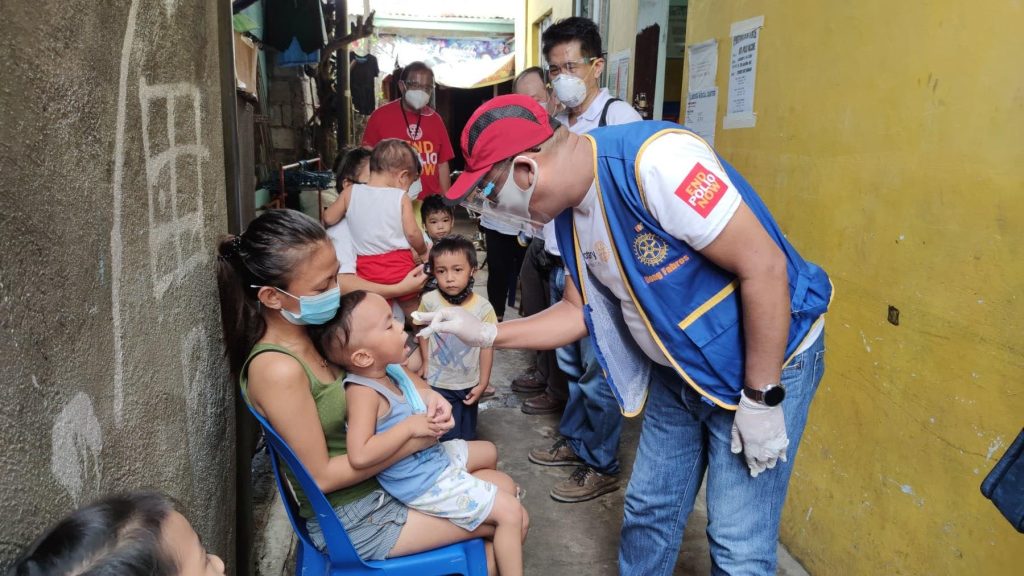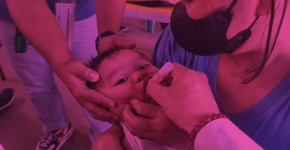On September 19, 2019, months before COVID-19 was discovered in the Philippines, the Department of Health (DOH) declared another polio outbreak, nearly two decades after the country was declared polio-free. The last case of wild poliovirus infection was reported in 1993, and the country, along with the rest of WHO’s Western Pacific Region, was declared wild polio-free in 2000.
Because of these new findings, the government, in collaboration with the World Health Organization (WHO), the United Nations International Children’s Emergency Fund (UNICEF), and partners such as Rotary International, launched nationwide polio campaigns to combat the virus’s spread.
Since its inception in 1996, the Rotary Foundation’s 3-H (Health, Hunger, and Humanity) program has awarded grants totaling $702,000. Some of the proceeds were used to immunize 6 million children against polio over a five-year period. Mabalacat and Angeles in Pampanga have become the pilot sites for an immunization program, and the Foundation also provides grants for large-scale international development projects that improve health, alleviate hunger, and enhance human and social development as a means of advancing international understanding, goodwill, and peace through the program.
Early Detection
Following the report of two polio cases, authorities inspected several locations, including Metro Manila and Davao City. The Philippine government decided to vaccinate all children, regardless of whether or not they had polio. Rotary International’s Global Polio Eradication Initiative (GPEI) collaborated with the Philippine government on a massive polio vaccination campaign, alongside the Department of Health (DOH) and other non-governmental organizations (NGOs) such as the Philippine Red Cross.
The Philippines had been free of polio-related diseases for 19 years until the DOH declared a polio outbreak after one polio case was confirmed in a 3-year-old girl from Lanao del Sur. There was a confirmed case and a suspected case of acute flaccid paralysis. The samples collected from sewage in Manila and waterways in Davao were then tested by the Research Institute for Tropical Medicine and verified by the Japan National Institute of Infectious Diseases and the Centers for Disease Control and Prevention in the United States.
Polio and COVID-19
Despite the enormous challenges posed by government immunization on the impact of COVID-19, the DOH maintained aggressive polio immunization campaigns.
According to official sources, a supplemental immunization campaign could reach 87.3 percent of the target population in the Philippines by March 31, 2021.
“In particular, UNICEF and WHO commend the DOH (Department of Health) for enhancing training and mobilizing health workers in infection prevention and control, and supplying them with personal protective equipment to be able to vaccinate children in their homes and in designated health centers — a global first in a country experiencing community transmission of COVID-19,” the media release said.
RELATED: Rotary Clubs Join COVID-19 Mega-Vaccination Drive
During this epidemic, WHO, UNICEF, and other private medical communities are collaborating to assist the Philippines Department of Health in conducting massive vaccination drives in Metro Manila, Davao City, Marawi, and other major cities throughout the country. The campaign aimed to halt the spread of the deadly virus.
According to the Philippine Red Cross, the mass vaccination run took place between October 14 and 27, 2019, with a target of 65,000 children vaccinated. The Department of Health (DOH), in close collaboration with local government units and concerned national agencies, and with the support of WHO, the United Nations Children’s Fund (UNICEF), and other partners, is preparing a rapid response to the polio outbreak. Beginning in October 2019, a series of synchronized oral polio vaccinations will be administered to all children under the age of five in high-risk areas. The DOH is also collaborating with partners to improve environmental and Acute Flaccid Paralysis surveillance across the country in order to detect poliovirus.
Rotary in Action
On October 6, 2014, the Philippines launched the Interactive Polio Vaccine (IPV) in high-risk areas of Metro Manila, Parañaque City, and later in Guimbal, Iloilo.
Health Secretary Francisco Duque III and ten district governors of Philippine Rotaries from across the country signed a Memorandum of Agreement establishing close collaboration in a determined campaign to combat the reintroduction of polio in the country. The DOH and Rotary have agreed that no child will be overlooked during the “Sabayang Patak Kontra Polio” or door-to-door vaccination campaign.
It should be noted that the Philippines’ fight against polio was declared a success in 1996, with no polio cases recorded. In order for a country to be certified by WHO, the country must first:
- At least three years with no confirmed cases of indigenous wild polio virus
- Excellent laboratory-based poliovirus surveillance
- Capability to detect, report, and respond to imported cases of poliomyelitis; and
- Assurance of polio virus containment in laboratories
Now that 99 percent of the world’s population lives in regions certified polio-free, the goal of eradication is closer than ever.

Winning to End Polio
“This is a major win for public health and is an excellent example of what collective efforts can attain, even in the midst of the COVID-19 pandemic. The closure of the polio outbreak is a direct result of strong political will and government leadership, the mobilization and engagement of resources and communities, the courage and commitment of healthcare and front-line workers, and the combined, coordinated efforts of the local governments and partners,” said Dr Rabindra Abeyasinghe, WHO Representative to the Philippines. “We look forward for these efforts to be sustained for a strong and resilient immunization system, utilizing the investments made for polio outbreak response and COVID-19 vaccination to ensure all children are protected from vaccine preventable diseases as the Philippines moves towards achieving Universal Health Care,” Dr Abeyasinghe added.
11 June 2021 — On behalf of the Global Polio Eradication Initiative (GPEI), WHO and UNICEF Philippines commend the Department of Health (DOH), government agencies, partners, and civil society for their efforts in ending the polio outbreak in the Philippines.
Aside from WHO and UNICEF, other GPEI core partners – Rotary International, the US Centers for Disease Control and Prevention, the Bill and Melinda Gates Foundation, and Gavi, the Vaccine Alliance – assisted in the response to the Philippine polio outbreak.
Rotary International continues its global campaign in the hope of finally eliminating polio from the face of the earth.
References:
- WHO, UNICEF laud end of polio outbreak in the Philippines https://www.who.int/philippines/news/detail/11-06-2021-who-unicef-laud-end-of-polio-outbreak-in-the-philippines, 11 June 2021
- 2019–2021 polio outbreak in the Philippines https://en.wikipedia.org/wiki/2019%E2%80%932021_polio_outbreak_in_the_Philippines
- Polio Once Caused Widespread Panic
https://www.cdc.gov/polio/what-is-polio/polio-us.html, August 3, 2022 - Polio makes a comeback in the Philippines 19 years after the country was declared free of the disease
https://edition.cnn.com/2019/09/19/health/philippines-polio-outbreak-intl/index.html, September 19, 2019 - How polio was erradicated in the Philippines, The Rotary Philippines, November 2021
- POLIO CASE CONFIRMED IN THE PHILIPPINES: DOH TO MOUNT MASS IMMUNIZATION CAMPAIGN, https://doh.gov.ph/node/18012, Sept 19, 2019

About Polio
Polio is a highly infectious, crippling, and sometimes fatal disease that was discovered during the 1940s outbreak in the United States. It disables more than 35,000 people each year and is preventable with a vaccine. Children under the age of five are especially at risk. Only two countries remain endemic for the disease, Afghanistan and Pakistan, and when it is eradicated there, polio will be only the second disease ever completely eradicated.




















